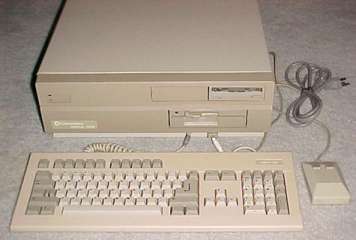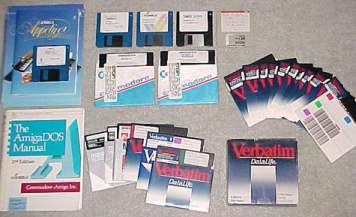
Commodore Amiga 2000

Developer: Commodore
Launched: March 1987
Discontinued: 1990 |
Two years after the initial Amiga launch, Commodore released
their replacement to the ageing Amiga 1000. The Amiga 2000
developed the 'big box' Amiga market that continued to divide
users' until the mid-1990s, and formed the second part of
Commodore's plans to diversify the Amiga market into high and low
end systems (the low-end A500 had been
launched two months previous). Like the Amiga 500, the A2000 was
shipped with Kickstart/Workbench
1.2.
The machine offered several advantages over the Amiga 1000 and
500:
- Seven internal expansion slots (5x 100 pin Amiga Zorro II
and 2 x 16-bit ISA slots). The ISA slots were disabled by default
(only power and ground pins activated), but could be used when a
Commodore bridgeboard was installed (a PC-on-a-card). Inactive
slots can be used for non intelligent cards like TBCs or fan
cards.
- One megabyte memory as standard (expandable to 9MB).
- The CPU could be upgraded through the purchase of a processor
card and attaching it to a 86 pin processor slot.
The initial release was unpopular among several Amiga developers,
including the original Amiga Los Gatos team. In an attempt to
address many of these complaints, Commodore produced two major
updates and numerous revisions to the A2000 design during the 1987
- 1990 time period.
A2000-A
A2000-B
A2000-C
A2000 variants
A2000-A
The first version of the A2000 was designed by a group in Germany.
It shares much of the A1000 design, integrating several parts of
the motherboard design. The system was based upon an interesting
design but was restricted in many ways:
- the thin Agnus could only use 512 Kb RAM
- the machine was unreliable representing a refinement of
1985 technology rather than an advancement. For example, the CPU
card slot was an internal version of the A1000 external edge
connector and the video slot was an internal version of the
external video port.
Later models were extended with digital video signals and some
parallel port lines.
| Dave Haynie commented on the original A2000 German
design:
Yes. The original A2000 was designed in Germany. It was
based on an integration of the A1000 motherboard design and the
example Zorro II backplane from "Schematics and Expansion
Specifications", the A1000 hardware manual. It used the thin Agnus,
which handled only 512K of DRAM. They added a "Genlock" slot, which
was essentially just the 23-bit video signals on an internal
connector, and the "MMU" slot, which was essentially just the A1000
external edge connector on an internal slot. The machine shipped
with 512K of Fast RAM in this slot, though the case was slow and
had some reliability problems. About 60,000 of these machines were
made, so I've heard.
|
A2000-B
The redesigned motherboard abandoned the German improvement on the
A1000, instead developing an American designed cost reduced version
of the A500. These are generally referred to in the UK as the
B2000.( You can check the version you have by
looking in the lower left hand corner. The later A2000 motherboard
are marked "B2000-CR". The original A2000's are marked on the left
side with "©1986 COMMODORE", "AMIGA 2000" and "MADE IN GERMANY
(BSW)).
As part of the cheaper design the control logic for the expansion
bus is integrated into the Buster and the 68000 and 1 Mb memory are
moved onto the motherboard. . The video slot is extended with more
signals and the CPU slot has a coprocessor interface. Early
versions of the B2000 shipped with Kickstart 1.2, later ones with
version 1.3.
The A2000-B design forms the majority of the number of A2000s
sold.
Dave Haynie commented on the B2000
model:
This was the original A2000-CR (Cost Reduced) that I designed.
I took the A500 chip set and integrated most of the control logic
for the expansion bus into a gate array called Buster (the original
thin Buster). This board was code-named the "B2000", not out of any
special letter-sequencing, but because it was made from some A500
parts -- the A500's code-name was the "B-52".
To to the German design, I added a second video connector,
which brought out the remaining 8-bits of digital the video signal
and some parallel port lines (just in case someone needed a way to
control something out there). I also designed a "coprocessor
interface" for the internal CPU slot, which allowed processor cards
to be added without the need to remove the 68000. And of course,
given the much higher integration (thanks to Buster, Gary, Fat
Agnus, etc), I was able to fit 1MB of RAM on the motherboard, even
though I went to a 2-layer board (management's demands for cost,
not my idea, though I did may it work OK.)
|
A2000-C
The final version of the A2000 is based upon the improved ECS
Chipset, but otherwise identical to the 2000b. It is also known as
the Amiga 2000+ in the US. This revision shipped with the new
improved Kickstart 2.04.

Variants
Besides the different versions of the A2000 released, there were
also two variants based upon the A2000 design and sold under a
different name. These were the A1500 and
A2500. More can be found about them by
visiting the pages covering these machines. Of particular interest
was the A2000HD that shipped with an A209x SCSI controller and a
SCSI hard disk drive installed.
Amiga 2000 Technical Specifications

| CPU |
68000@7.14 Mhz |
| Custom Chips |
Denise - 8362 Denise, REV6.3+ had 8373 SuperDenise
Paula
Fat Agnus
Gary |
| Buster |
ZorroII Buster DIP |
| Video |
OCS or ECS (4096 colors) |
| Kickstarts |
1.2, 1.3 then 2.04 |
| Memory |
Memory varied according to the hardware revision.
The 3.x revisions found in German models use 512Kb Chip RAM on
their motherboard and 512Kb Fast RAM on a processor card.
Revision 4.x, the American edition, had both 512Kb Chip and Fast
RAM soldered onto the motherboard.
Later versions of the B2000 and C2000 based upon revision 6.x
design included 1 Mb Chip RAM.
|
| Drives |
Internal 880K floppy
SCSI HD in 2000HD models |
| Drive bays |
2x 3.5" front bays
1x 5.25" front bay
(in the A1500 model both of the 3.5" bays are occupied with 880Kb
DD floppy disk drives.) |
| Slots |
1 - Video
1 - CPU
5 - Zorro II
2 - 8 bit ISA
2 - 16 bit ISA in line with Zorro II slots |
| Interfaces |
1x Serial DB25 male, RS232
1x Internal serial 26 pin header
1x Parallel DB25 female, Centronics
1x Video DB23 male, analog RGB
1x Composite, black & white
2x Mouse/game DB9 male
2x Stereo audio RCA jack
1x Keyboard 5 pin DIN female
1x External floppy DB23 female
1x Internal floppy 34 pin header |
Gallery
A2000 motherboard (80k)
A2000 motherboard v6.2
(62K)
Local Links
Prototypes that would
become classics - a rare A2000 Revision 5 board
The Amiga Chronology
BACK
Last Update: 1/11/2001
|













